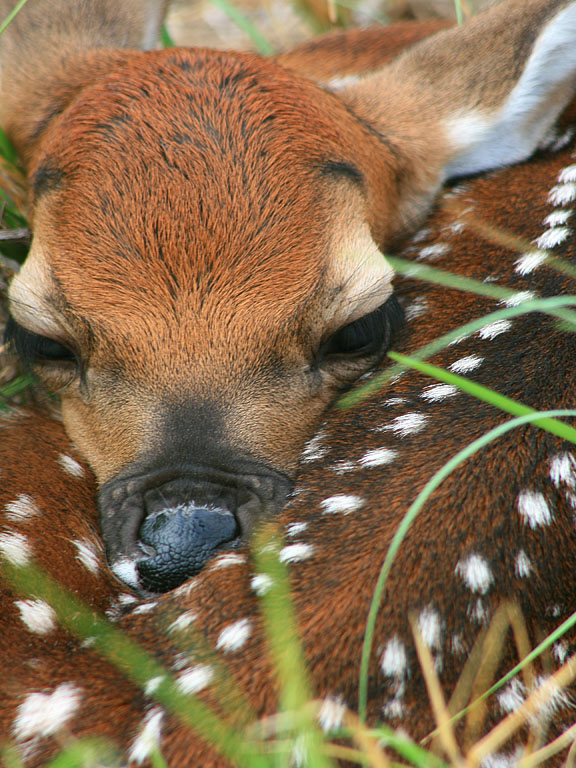I asked Todd if I could use the fawn image he posted in the gallery to generate a discussion on how much image manipulation is acceptable, and when.
Notice that I didn't ask
if image manipulation was acceptable, but
how much. Whether you like it or not, a certain level of manipulation is inherent in all digital and film processing. As many of you know, Ansel Adams was a master in the darkroom, and spent many hours adjusting the tonality of his prints in order to present his "vision" of the scene. In the pre-digital era, Velvia slide film became the most popular film amongst nature photographers because of the "punch" it lent to images due to the increased saturation and contrast. The default settings of most digital cameras also increase the saturation and contrast in order present a more pleasing "out of camera" image. Most people, when presented with a "faithful" reproduction of a scene, and a reproduction with more saturated colors, will pick the more saturated scene as the most pleasing (within limits). The scientific basis for this preference is actually well documented in the Hunt Effect, as discussed in this article on the LibRaw website:
http://www.libraw.org/articles/raw-ciecam02.html The article states "the main essence of the effect is that as you increase the luminance, the perceived color saturation increases too. Therefore, since we are studying photos under a much dimmer light than the one present in the original scene (at least for landscape shots during the daylight), this difference needs to be compensated." So, it's not really a matter of
if you find image manipulation acceptable, but
how much.
To set the context for this discussion, Todd's description of this image stated: "This newborn whitetail fawn remained motionless as I captured several photos. Jake, my dog, deserves the credit for finding this one in the tall grass." Cindy Miller Hopkins commented on the image, saying "another very nice shot, I would have liked to seen a little eye shine ... " Which leads me to reveal a little secret. This is actually Todd's version of the image:

I presented the modified version first, because I wanted you to look at the image with an unsuspecting eye, and not immediately be predisposed to think of it as a "fake." Obviously, in the "modified" version of the image, I added the "little eye shine" that Cindy wanted to see. Why? Because an image of any animal (or person) is usually lifeless and un-engaging if the eyes are dark or out of focus. This modification took me only a few seconds in Photoshop, yet the casual observer will be much more engaged by this image than the one with "lifeless" eyes.
So what were Todd's objectives when presenting the image, and are they better served by presenting the "modified" image? If the objective is to engage the viewer and impart a sense of wonder at this magical moment of finding a newborn fawn in the tall grass, then I would argue that the modified version better meets these objectives. Is it a fake? Or does it better represent the scene as Todd saw it? I can pretty much guarantee that when Todd was watching the fawn, he saw more "life" in the fawn's eyes that what is presented in the unmodified image. Unfortunately, digital sensors don't have the adaptive capabilities of our eyes and brains to adjust for scene brightness and resolve detail in the dark shadow of an eye socket.
The International League of Conservation Photographers addresses the issue of digital manipulation by stating, "The documentary power of a photograph is directly linked to its value as a record of real events. Yet, with the advent of digital technology, the manipulation of images has become both easier and more widespread and can undermine public confidence in photography as a factual record. For this reason, we believe that image manipulation must never alter essential content in such a way that it either misrepresents actual events, or deceives the intended audience, in any context in which the truth of the image is assumed. Creative manipulation, when performed, must be fully disclosed to the end user."
I would argue that adding a highlight to the eye is the equivalent of the dodge and burn techniques that Ansel Adams used in the darkroom to adjust the tonality of his prints. In fact, the tool I used in Photoshop to add the highlight was the "dodge" tool. The modified image of the fawn neither "misrepresents actual events, or deceives the intended audience." If Todd were presenting the image as his own work, no disclosure of this "manipulation" would be necessary. If Todd were selling this image to an agency that had a stated policy on image manipulation, he would need to "fully disclose" the extent of image manipulation used to produce the final image. (Note that I also used the clone tool to remove a distracting piece of grass from in front of the fawn's face. Again, I would not consider this level of manipulation as "misrepresenting actual events or deceiving the audience.")
Obviously I posted these thoughts in order to generate dialog on the subject. I would be interested in hearing the viewpoints of other photographers on the acceptable limits of "image manipulation."
(Another "take away" from this discussion might be understanding the value of shooting your images to obtain a highlight in the eye. The pop up flash on Todd's camera would have been sufficient to provide a pleasing "catch light" in the fawn's eye, and then he wouldn't have to worry about adding the highlight after the fact.

Keith